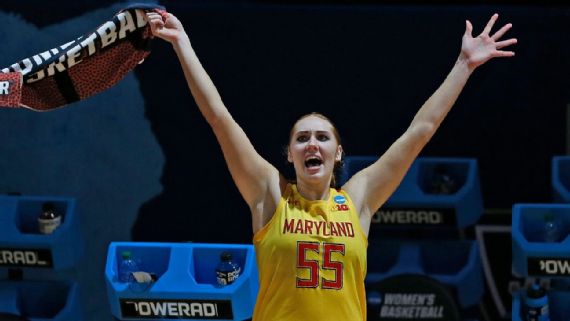This marks the third consecutive NCAA tournament that the top eight seeds reached the regionals, but the first time since 2013 that as many as six teams outside the top four seeds have gotten this far.
The Big Ten is the story of the field. The SEC began with six teams in the top 16 seeds, but only two remain. For the first time in conference history, four Big Ten teams advanced to the women’s Sweet 16. Michigan is making its first trip. Indiana returns for the first time since 1983. Maryland and Iowa were here in 2019, but with very different teams.
All four Big Ten teams were reseeded in our updated ranking of the Sweet 16.
 1. Stanford Cardinal (Original seed: No. 1. Reseed: No. 1)
1. Stanford Cardinal (Original seed: No. 1. Reseed: No. 1)
The Cardinal’s margin of victory in the second round wasn’t as great as that of the other No. 1 seeds on this list, but it was impressive and had all the makings of a trademark Stanford win. The Cardinal led by 15 at the half and put the game in cruise control. Eight different players scored, four in double figures. Stanford held Oklahoma State star Natasha Mack to 13 points, her lowest total since Jan. 2. Haley Jones led the team in scoring (17 points), the first time she had done that in over a month. And that Stanford versatility was on display: Tuesday’s win marked the sixth time in seven games the Cardinal had a different leading scorer.
 2. UConn Huskies (Original seed: No. 1. Reseed: No. 1)
2. UConn Huskies (Original seed: No. 1. Reseed: No. 1)
The Huskies get coach Geno Auriemma back from his COVID-19 quarantine for the regionals and just in time for Freshmen Fest, the much-desired and highly anticipated meeting of rookies Caitlin Clark of Iowa and UConn’s Paige Bueckers. In the second round, the Huskies systematically dissected the Syracuse zone and held the Orange to 28% shooting. Bueckers’ 20 points led the way, but it’s another freshman, 6-foot-3 Aaliyah Edwards, who continues to emerge. She averaged 18.5 points and 8.5 rebounds in UConn’s first two NCAA tournament wins. Edwards started for just the third time this season on Tuesday as fellow freshman Nika Mühl remained sidelined after suffering an ankle injury in UConn’s first-round victory.
 3. South Carolina Gamecocks (Original seed: No. 1. Reseed: No. 1)
3. South Carolina Gamecocks (Original seed: No. 1. Reseed: No. 1)
A year ago, the Gamecocks were the most dominant team in the country but lost their chance to be billed as the favorite when the 2020 NCAA tournament was canceled. This year South Carolina remains one of the favorites and is at least as dominant defensively. Mercer and Oregon State shot just 34.4% in South Carolina’s two wins. The 95 combined points the Gamecocks allowed in the first two rounds were the lowest two-game total a team has given up in the tournament. They particularly sparkled against the Beavers. Oregon State is the third-most accurate 3-point shooting team in the country but was just 3-of-19 on Tuesday, and the Beavers’ 42 points were a season low. South Carolina’s own 3-point shooting (4-for-29 in two games) might be a concern.
 4. Baylor Lady Bears (Original seed: No. 2. Reseed: No. 1)
4. Baylor Lady Bears (Original seed: No. 2. Reseed: No. 1)
It was tempting to move the Lady Bears even higher. They have probably been the most impressive team in the NCAA tournament so far. But starting seed plays a role in this reseeding exercise, and it’s not as though Stanford, UConn and South Carolina haven’t also been dominant. So Baylor stays at No. 4 overall. Coach Kim Mulkey thinks her defense is No. 1 right now, exclaiming after Tuesday’s second-round win over Virginia Tech, “That’s as impressive a defense as I’ve ever put on the floor in an NCAA tournament game, maybe in all of my coaching.”
Baylor is one of if not the best defensive teams in the country this season and leads the nation in field goal percentage defense, so having a game in which a good Hokies offense shoots only 30% is no surprise. But it’s also nothing new for the Lady Bears. The 2019 national championship team and last year’s 28-2 team also topped the country, allowing opponents to shoot just 31%. Baylor scores 82.6 points per game but really does win with defense.

 5. Maryland Terrapins (Original seed: No. 2. Reseed: No. 2)
5. Maryland Terrapins (Original seed: No. 2. Reseed: No. 2)
Maryland, the conference’s regular-season and tournament champion, leads the charge for the Big Ten. The Terps are also lapping much of the field when it comes to offense in San Antonio. Some of the winning point totals in Wednesday’s games were 64, 57 and 53. Maryland beat Alabama 100-64. In women’s NCAA tournament history, only three other teams have scored at least 98 points in their first two tourney games (2018 Notre Dame, 1989 Stanford and 1988 Long Beach State). Against the Crimson Tide, the Terps shot 62% from the field and had two players off the bench lead the way — Angel Reese (19 points) and Faith Masonius (16 points). There are scorers everywhere in their rotation.
 6. NC State Wolfpack (Original seed: No. 1. Reseed: No. 2)
6. NC State Wolfpack (Original seed: No. 1. Reseed: No. 2)
On Tuesday in the second round, the Wolfpack played without starter Kayla Jones. Star center Elissa Cunane had another off day. They won only two of the four quarters against South Florida. Still, they beat a team with a regular-season and conference tournament title on its résumé by double figures. Toughness and talent reign once again for NC State. Jones injured her knee in the first round, and her status for the regionals is uncertain. Cunane is now just 6-of-22 from the field with a pair of 12-point games in the NCAA tournament. The term “survive and advance” began in Raleigh with the men’s team and Jim Valvano. With Jones out and Cunane struggling, that’s exactly what the Wolfpack have to do.
 7. Louisville Cardinals (Original seed: No. 2. Reseed: No. 2)
7. Louisville Cardinals (Original seed: No. 2. Reseed: No. 2)
On Wednesday, the Cardinals allowed their most points in the first quarter all season (25), and the 10 they scored marked their lowest output to start a game in 2020-21. Their 18-point deficit also was their largest of the season. And yet, the Cardinals erased it all to beat Northwestern 62-53 to reach the Sweet 16 for the fourth straight NCAA tournament. After their nine field goals and 25 points in the first quarter, the Wildcats made just 11 more field goals and scored 28 points over the final 30 minutes. Louisville has no defensive worries, but it might have concerns about Dana Evans. Since the start of the ACC tournament, the senior star is shooting 30% from the field and averaging 13 points per game. That’s after 18.1 PPG and 45% shooting in the regular season. Louisville’s freshmen stepped to the forefront against Northwestern. Hailey Van Lith and Olivia Cochran each had 13 points as Louisville tied for the third largest comeback in women’s NCAA tournament history.
 8. Texas A&M Aggies (Original seed: No. 2. Reseed: No. 2)
8. Texas A&M Aggies (Original seed: No. 2. Reseed: No. 2)
After her winning shot at the overtime buzzer to beat Iowa State, Jordan Nixon said that having her teammates’ and coaches’ trust is the key to her success in College Station. She has given them good reason. Nixon has been Texas A&M’s top scorer in both NCAA tournament games, scoring 35 while playing all 45 minutes against the Cyclones. The Aggies never led until the overtime, and coach Gary Blair — doubling down on that trust — didn’t call timeout on the final possession, instead letting Nixon go to work in the lane for a runner high off the glass to win it. Two victories by a total of six points have kept Texas A&M alive. The Aggies also survived a 32-point game by Iowa State’s Ashley Joens, who leaves with a tournament-best 65 total points in two games.
 9. Arizona Wildcats (Original seed: No. 3. Reseed: No. 3)
9. Arizona Wildcats (Original seed: No. 3. Reseed: No. 3)
The Wildcats might not have perfected the art of winning ugly, but they have visited the museum. No matter. Arizona fought to a 52-46 second-round win over BYU to reach the second Sweet 16 in school history — and head coach Adia Barnes was a senior star for the Wildcats on the first trip. This has been the goal ever since she returned to Tucson in 2016. Aari McDonald arrived in 2017 as a transfer from Washington (where Barnes had been an assistant), and the two have partnered to revive the program. McDonald, a senior who is a two-time Pac-12 defensive player of the year, scored 17 points and led a defense that held BYU’s outstanding guard duo of Paisley Harding and Shaylee Gonzales to a combined 6-of-22 from the field.
 10. Indiana Hoosiers (Original seed: No. 4. Reseed: No. 3)
10. Indiana Hoosiers (Original seed: No. 4. Reseed: No. 3)
Some teams, players and storylines just get more attention in the NCAA tournament than others. It’s a great individual performance, a high-scoring game or a buzzer-beater that draws the heaviest interest. Indiana has had none of that. With little fanfare, the Hoosiers have gone about their business better than the crew Gene Hackman had in Hickory and are exactly where they planned to be when the season started. If Big Ten partner Maryland is the offensive team of the tournament, then Indiana gets the defensive award. The Terps scored 100 in one game. Indiana has allowed a total of 80 in two. That’s a defense-first team in a league known for scoring. That will keep you under the radar for only so long.
 11. Iowa Hawkeyes (Original seed: No. 5. Reseed: No. 3)
11. Iowa Hawkeyes (Original seed: No. 5. Reseed: No. 3)
Iowa is more than just Caitlin Clark. Some games she just makes it hard to prove it. Her 24 first-half points in Tuesday’s second round were more than that of the entire Kentucky team. Clark’s 35 total points and six 3-pointers are both Iowa school records in an NCAA tournament game. To reach their third Sweet 16 in six years, the Hawkeyes have stuck to the formula that has been successful all season: In their first 27 games, they averaged 86.6 points per game on 51.5% shooting. In two NCAA tournament games, the numbers are 86.5 and 52.3. And Clark, the nation’s leading scorer, is quick to share the praise and the ball, especially with junior Monika Czinano, who leads the nation in field goal percentage. “She has great hands, great vision, she knows when the ball is coming, even if I’m not looking straight at her,” Clark said. “I want to feed her the ball every opportunity I get.”
 12. Missouri State Lady Bears (Original seed: No. 5. Reseed: No. 3)
12. Missouri State Lady Bears (Original seed: No. 5. Reseed: No. 3)
Someone in the Missouri State program likely spent some long hours watching video of Wright State’s win over Arkansas. Angel Baker carried the Raiders in the biggest upset of the tournament. The Lady Bears did not let that happen twice. Baker’s output went from 26 to 10 points. Without Baker, Wright State had no other options. Missouri State was effective from 3-point range (8-of-16) and the free throw line (14-of-17), and that was good enough for a 64-39 victory, the fewest points the Lady Bears have allowed in an NCAA tournament game. That’s a second consecutive Sweet 16 trip and two wins from a Final Four on the 20th anniversary of the memorable Jackie Stiles 2001 run.
 13. Michigan Wolverines (Original seed: No. 6. Reseed: No. 4)
13. Michigan Wolverines (Original seed: No. 6. Reseed: No. 4)
Naz Hillmon typically drives any conversation around Michigan basketball. Perhaps the Wolverines’ defense should have gotten as much attention. After finishing fourth in the Big Ten in points allowed (that’s in a conference with three of the 10 highest-scoring teams in the country), the Wolverines have showed off their defensive strength and versatility in San Antonio. No team faced such diverse offensive opponents and flourished as much. Florida Gulf Coast led the country in made 3-point field goals per game, but the Eagles shot 9-of-29 in the first round. Tennessee was second in the SEC in offensive rebounds and doesn’t have a starter shorter than 6-1, but the Wolverines outrebounded the Lady Vols 42-40. Michigan held them both to 17 points below their season average on the way to the program’s first Sweet 16 appearance.
 14. Texas Longhorns (Original seed: No. 6. Reseed: No. 4)
14. Texas Longhorns (Original seed: No. 6. Reseed: No. 4)
Vic Schaefer knows the formula, having been to the Sweet 16 four times as a head coach at Mississippi State. He just had to teach all its elements to his Longhorns. Consider the lesson learned. Texas guards came up big, as Celeste Taylor scored 24 points, Kyra Lambert had 17 points and 10 rebounds and Joanne Allen-Taylor added 16 points. In the final game of the second round, Texas beat No. 3 seed UCLA 71-62 to become the sixth No. 5 seed or higher to reach the Sweet 16. The Longhorns got out quickly and held the Bruins to 14 first-half points. Maryland is up next, and the formula for beating the Terps will demand more from star center Charli Collier, who had five points and five rebounds Wednesday.
 15. Oregon Ducks (Original seed: No. 6. Reseed: No. 4)
15. Oregon Ducks (Original seed: No. 6. Reseed: No. 4)
Perhaps the Ducks just needed a break. After losing to Oregon State in the Pac-12 tournament quarterfinals — the Ducks’ fifth loss in six games — Oregon had 18 days off until its NCAA tournament opener on Monday. Now the Ducks have two wins and a Sweet 16 berth. And who might have guessed back in November that it would be the defense leading the way in a 57-50 upset of Georgia, matching a season-low in points for the SEC’s third-place finishers. Sedona Prince gained notoriety for shining a light on the inequalities between the men’s and women’s NCAA tournaments, but Wednesday was all about her two-way play. Prince, a Texas transfer who has battled injuries her entire career, matched her season high with 22 points to go with five rebounds and four blocks.
 16. Georgia Tech Yellow Jackets (Original seed: No. 5. Reseed: No. 4)
16. Georgia Tech Yellow Jackets (Original seed: No. 5. Reseed: No. 4)
Nothing like an NCAA tournament second-round game to find your shooting touch. Georgia Tech finished third in the ACC and earned a No. 5 seed based on its defense. But the 54-52 overtime win over Stephen F. Austin in the first round came because the Yellow Jackets got stop after stop in the second half. The offense finally did its part in an impressive 73-56 victory over West Virginia. A team that ranked 13th in the ACC in scoring and shot 41.3% in the regular season made over half its shots against the Mountaineers and scored its most points since Feb. 2. The defense was great, too, holding West Virginia All-American Kysre Gondrezick to just three points.
Credit: Source link